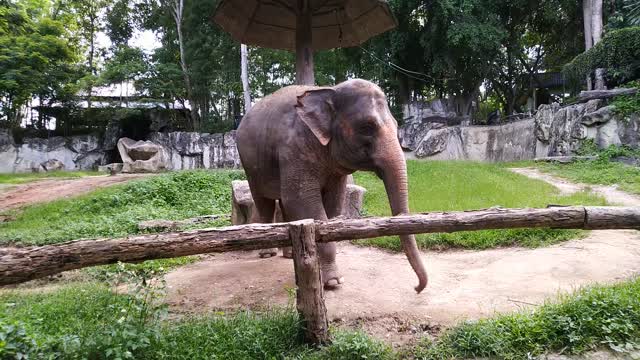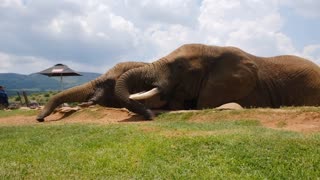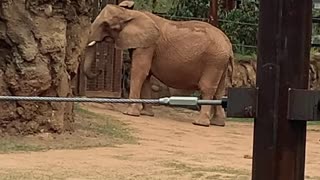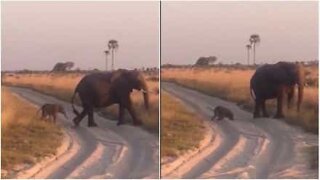Premium Only Content

Elephant is playing, look like sand storm
Enjoy watching Elephant is playing, look like sand storm.
Elephants are the largest land animals on Earth, and they're one of the most unique-looking animals, too. With their characteristic long noses, or trunks; large, floppy ears; and wide, thick legs, there is no other animal with a similar physique.
Most experts recognize two species of elephant: the Asian elephant (Elephas maximus) and the African elephant (Loxodonta africana), who live on separate continents and have many unique features. There are several subspecies that belong to one or the other of these two main species, though experts argue over how many subspecies there are and whether or not they constitute separate species, according to the San Diego Zoo.
African and Asian elephants
African elephants live in sub-Saharan Africa, the rainforests of Central and West Africa and the Sahel desert in Mali, according to National Geographic. Asian elephants live in Nepal, India and Southeast Asia in scrub forests and rainforests. [Elephant Images: The Biggest Beasts on Land]
African elephants are the larger of the two species. They grow to between 8.2 and 13 feet (2.5 and 4 meters) tall at the shoulder and weigh 5,000 to 14,000 lbs. (2,268 to 6,350 kilograms), according to National Geographic. Asian elephants are just a little smaller, growing to between 6.6 and 9.8 feet (2 and 3 m) tall at the shoulder and weighing between 4,500 and 11,000 lbs. (2,041 and 4,990 kg). In the wild, African elephants can live up to 70 years, and Asian elephants up to 60 years.
African and Asian elephants also have a few different physical features.
The ears of African elephant are larger and resemble the shape of the African continent, while Asian elephants have smaller, rounder ears, according to the San Diego Zoo.
Both male and female African elephants have large tusks and two "fingers" on the end of their trunks to help them pick items up. Asian elephants have a single "finger" on the end of their trucks. But typically, only male Asian elephants will grow large tusks, while the females and a few males have much smaller tusks called tushes that don't always grow outside the mouth.
Tusks are large, deeply rooted teeth that evolved to assist the elephant in digging, lifting, gathering food, and defense while also protecting the trunk, according to World Wildlife Fund. In the same way that humans tend to be right-handed or left-handed, elephants can be right-tusked or left-tusked. Their dominant tusk is easy to identify, because it will be more worn down than the less dominant tusk, according to the World Wildlife Fund.
Chiang Mai Zoo
Chiang Mai Zoo and Aquarium is a 200-acre (81 ha) zoo on Huay Kaew Road, Chiang Mai Province, Thailand, just west of Chiang Mai University. It is the first commercial zoo in northern Thailand, established on 16 June 1977.
In 1950 the US government sent military advisers to train tribal police along the border of Thailand. Among them was Harold Mason Young, son of American missionaries, who had been born in Burma. Young started helping injured animals, and his collection started getting visitors. The Chiang Mai provincial government set aside 24 acres (9.7 ha) at the base of Doi Suthep, the mountain immediately adjacent to Chiang Mai, and the facility was opened to the public in 1957.[1][3]
When Young died in 1974, the property was taken over by Chiang Mai Province. The zoo was expanded to its current 200 acres (81 ha) footprint, transferred to the Zoological Park Organization under the patronage of the King of Thailand, and opened as the official zoo of Chang Mai Province in 1977
-
 0:48
0:48
Dezaray
4 years ago $0.01 earnedSpice playing with his Elephant
181 -
 0:24
0:24
Pet Channel
4 years agoLook at the elephant Abu Khartoum long, Jamal
27 -
 1:16
1:16
ryerye1975
4 years agoBella playing
147 -
 6:07
6:07
ShonanBeachRC
4 years agoTamiya Rising Storm DF-02 Crazy Sand Burnout! lol
76 -
 0:19
0:19
MrsMamaW
4 years agoSwaying Elephant
1132 -
 0:45
0:45
Buzzvideos - EN
4 years agoBaby elephant falls clumsily into the sand
11 -
 0:55
0:55
highvoltage1107
4 years agoRen playing
851 -
 1:01:15
1:01:15
The Dan Bongino Show
2 hours agoFreedom Is Winning, And The Libs Are Pulling Their Hair Out (Ep. 2407) - 01/23/2025
198K763 -
 1:02:52
1:02:52
The Rubin Report
1 hour agoChilling Video from World Economic Forum Head Makes His 2025 Plans Clear
5.2K20 -
 2:15:01
2:15:01
Steven Crowder
3 hours agoHow Trump's Deportation Plan will Save America... And Europe
199K165